If you have a budget for paid social, you should strongly consider running Instagram ads. Why?
Ads on Instagram reach 96.6% of Instagram’s active user base every month. That’s a total of almost 2 billion potential customers! And the target group is still growing — data from Meta shows that Instagram’s ad reach has jumped by 21% in the last year, despite changes in its ad reporting.
This guide will walk you through how to advertise on Instagram, including an easy guide to creating your first Instagram ad.
What are Instagram ads?
Instagram ads are posts businesses can pay to serve to specific target groups on Instagram.
These ads appear in users’ feeds, Stories, and explore pages in the same format as organic content from other Instagram accounts.
Instagram ads can contain images, videos, carousels (multiple images), or collections (dynamic product galleries).
Instagram ads look similar to normal posts but always contain a Sponsored label to indicate that they are an ad. They also often have more features than a normal post, such as links, CTA buttons, and product tags.

How much do Instagram ads cost?
The cost of Instagram ads depends on the total budget, duration, and objectives you’ve set for your ad or campaign. You can set a daily or lifetime budget for your Instagram ads, so it’s up to you how much you want to spend. Note that there is no best practice for how much to spend, but Meta recommends starting with at least $5.00 per day.
While there is no average or benchmark price, some cost factors can include:
- Your specific audience targeting
- The competitiveness of your industry
- The time of year (costs often go up during holiday shopping periods in Q4 such as Black Friday)
- Your chosen placement (costs can differ between ads shown on Facebook vs Instagram)
Advertisers can set their maximum bids for each auction or let Instagram optimize them automatically. So, if you’re new to advertising through Instagram, it’s best to start with a low maximum bid to gain some experience.
Once you have gained more insight into the competitive landscape for your chosen industry and demographics, you can decide if raising your maximum bid is necessary.
The best way to evaluate your budget is to set up a draft campaign in the Instagram Ad Manager and look for the Audience Definition and Estimated Daily Results modules, which will tell you if your budget settings will be sufficient to reach your desired audience within your desired campaign duration.
Types of Instagram ads
There are many different types of advertising formats on Instagram, including:
- Image ads
- Story ads
- Video ads
- Carousel ads
- Collection ads
- Explore ads
- Shopping ads
- Reels ads
The wide range means that you can choose the best ad type that matches your specific business goals. Instagram ads now support six simplified campaign objectives. Call-to-action options will vary based on the ad type and objective you choose, see more on that below.
Image ads
Instagram image ads allow businesses to use single images to advertise their brand, products, and services.
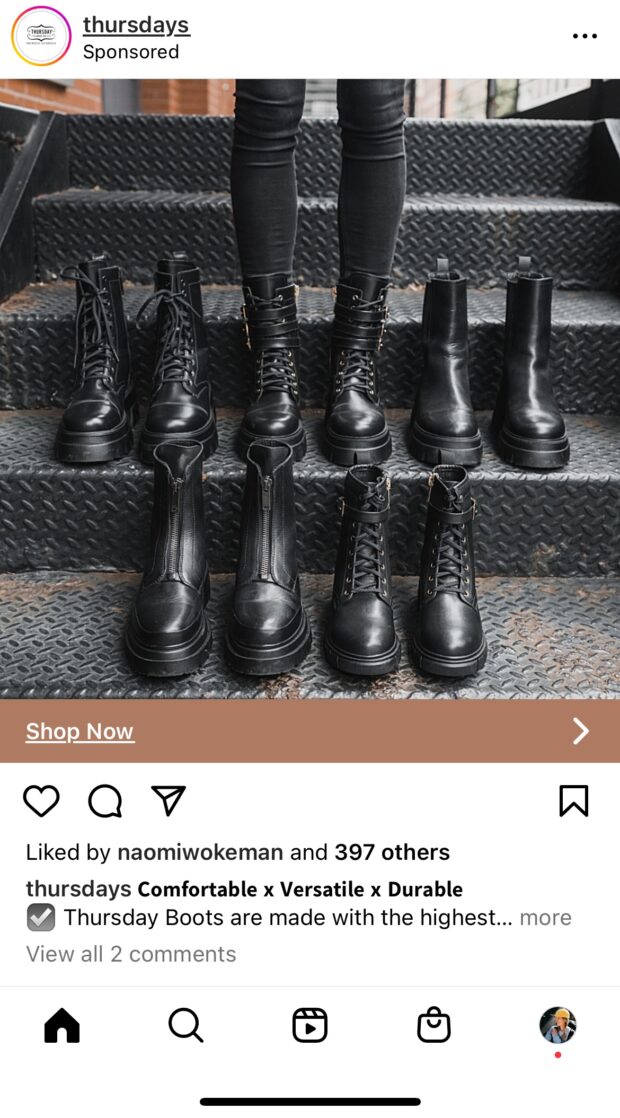
Instagram image ads are best suited for campaigns with compelling visual content that can be conveyed in a single image. These images can be created from high-quality photography or design and illustration.
It’s also possible to add text to images. However, Instagram recommends limiting overlaid text as much as possible for accessibility and best results.
Video ads
Instagram video ads are a great way to showcase your product or service in an engaging, eye-catching way. You can use video ads to demonstrate how products work, highlight unique features, or simply tell your brand story.
In-feed video ads can be up to 60 minutes long, but shorter videos are usually more effective.

Story ads
Instagram Story Ads are full-screen image or video ads that appear between users’ Stories.

Instagram Stories are a well-used part of the app, with over 500 million Instagram users viewing Stories every day. Engagement is often higher with Stories ads, as the format covers the mobile screen and feels much more immersive than in-feed ads.
The best Instagram Stories ads look and feel like normal Stories and don’t stand out as ads. When designing Stories ads, businesses can use all organic Instagram Stories features like filters, text, GIFs, and interactive stickers.
Stories ads can use still photos, videos, and carousels. The call-to-action is presented as a swipe-up link at the bottom of the Story.
Carousel ads
Instagram carousel ads feature a series of images or videos that users can swipe through. They can appear both in-feed and within Instagram Stories, with a call-to-action button or swipe-up link that leads users directly to your website.
You can use carousel ads to:
- Showcase a collection of related products
- Tell a multi-part story
- Share up to 10 images or videos
Collection ads
Instagram collection ads are a combination between carousel ads and shopping ads. Collection ads showcase products directly from your product catalog.
Collection ads are best suited for ecommerce brands, as they allow users to purchase products directly from the ad. When a user clicks on the ad, they’re directed to an Instagram Instant Experience Storefront where they can learn more about the product and proceed to purchase.
Explore ads

Explore ads appear within the Explore tab, an area of the platform where users discover new content and accounts that are tailored based on their Instagram usage habits.
Instagram Explore ads do not appear in the Explore grid or the topic channels, but rather are shown after someone clicks on a photo or video from Explore. As the content in users’ Explore tabs is constantly changing, Explore ads allow businesses to be shown alongside culturally relevant and trending content.
Explore ads can be both images and videos.
Pro Tip: No need to design brand new assets for Explore ads. You can simply re-use existing Instagram ad assets.
Reels ads
With the successful launch of Reels, Instagram recently announced the ability to advertise within Reels.
Ads are shown in between Reels, with similar specs to Stories ads (full-screen vertical videos), and can be up to 60 seconds. They should include sound or music to be well-integrated with organic Reels. All Instagram Reels ads will show a Sponsored mark underneath the account name.
Note that Instagram Reels ads will loop infinitely unless stopped. As well, users can like, share, comment, and save your Reels ads.
Shopping ads
With 44% of Instagram users shopping on the platform every week, it’s no wonder Instagram has been heavily improving its ecommerce features over the last 1-2 years.
With Instagram’s newest Shopping features, users can now view and purchase products without leaving the app (limited to businesses with Instagram Checkout enabled).
Instagram Shopping ads take users directly to a product description page within the Instagram app. They can then purchase through your mobile website.
To run Shopping ads, you need to set up your Instagram Shopping catalog.

Pro tip: Take advantage of Hootsuite’s integration with Shopify to access your catalog right from your Hootsuite dashboard.
How to advertise on Instagram: setting up an ad step-by-step
There are two routes for creating Instagram ads campaigns: boosting an existing post and creating a new ad in the Meta Ads Manager (f.k.a. Facebook Ads Manager). Promoting an existing post only takes a few taps and can be done right from the Instagram app, but lacks the customization options available in Instagram Ads Manager.
Below, we’ll walk you through both methods.
Method 1: Using Instagram Boost
The easiest way to start advertising on Instagram is to promote one of your existing posts. This is similar to Facebook’s Boost Post option.
If you have a post that is performing well in terms of engagement, promoting it within the app is a quick and easy method to scale up the post’s success—and show it to new people who aren’t following you yet. 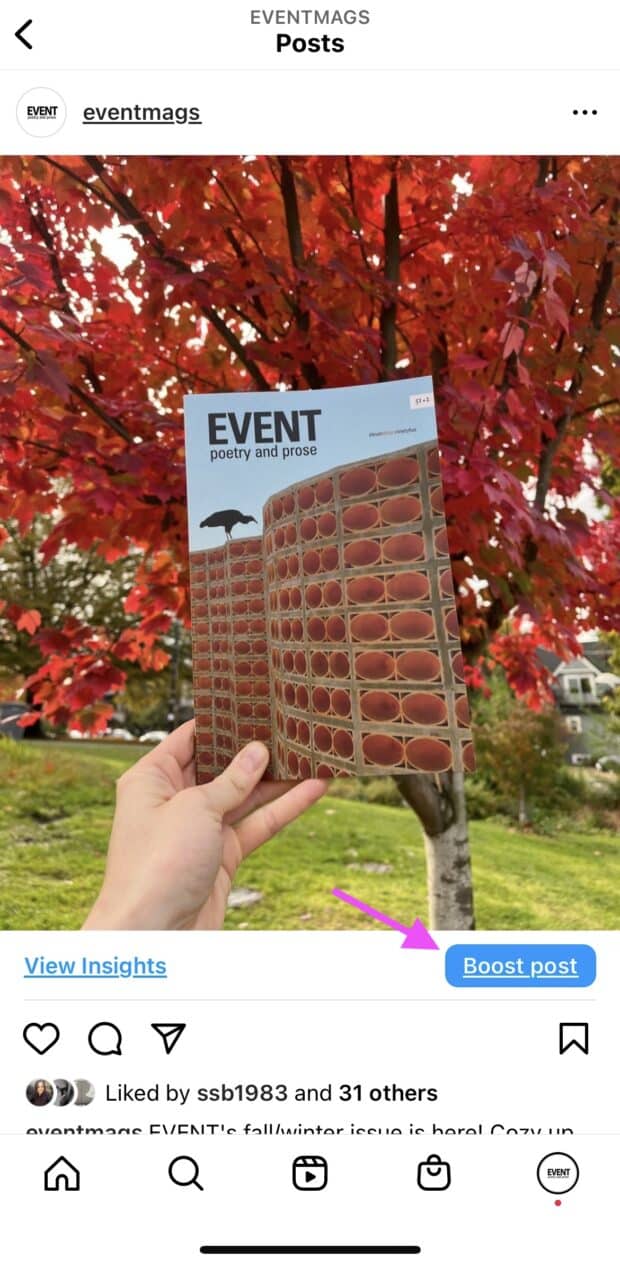
You’ll need a business or creator account on Instagram to do this. You’ll also need to have a Facebook Business Page connected to your Instagram account .
Then, it’s as simple as clicking Boost post on the post you wish to turn into an ad.
Next, choose your goal. You’ll have three options: more profile visits, more website visits, or more messages (this includes more WhatsApp messages).
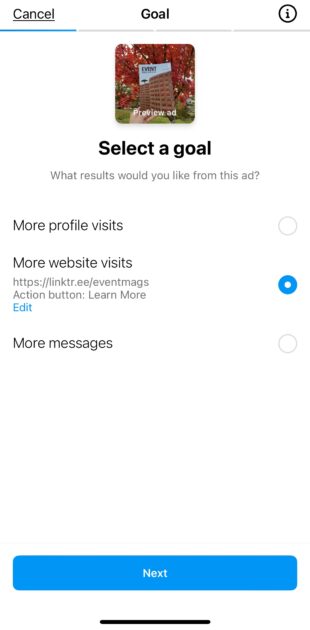
Then, define your audience. You can either choose to let Instagram automatically determine your audience (based on your follower data). Or, you can create your own audience by manually entering your targeting options.
You can also choose to run the boosted post on Facebook, if you want.

Now choose your daily budget and the duration of time you want the ad to run. You can either choose a set number of days or let it run infinitely until you manually pause it.
Finally, review your ad and click Boost post when you’re ready to go live.
That’s it! Your ad will be reviewed and approved by Facebook. Once it goes live, monitor your ad’s results in the Promotions tab of your Instagram profile.
Method 2: Using Ads Manager
To get the most out of Instagram’s extensive ad targeting, creative, and reporting abilities, you can use the Meta Ads Manager to create ad campaigns (remember that Meta owns Instagram).
Although it requires a bit more work, our 8-step guide will guide you through the process.
Step 1: Create a new Instagram ad campaign
To start, go to Meta Ads Manager and click +Create.
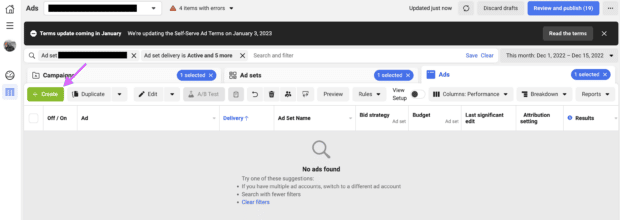
Step 2: Choose your objective
You can choose to pair your ad with an existing campaign, or start a new one from scratch. To start a new campaign, you’ll need to choose your objective first.
There are six campaign objectives available for Instagram ads. Those are:
Awareness: Reach the largest number of people who are most likely to remember your ad.
Traffic: Send people directly to your website, Instagram Shop, or app.
Engagement: Increase views, likes, comments and shares on your Instagram posts.
Leads: Collect leads for your business via Instagram ads. Or, encourage them to share information in exchange for content.
App promotion: Promote app engagement and Installs.
Sales: Find people likely to purchase your goods or services and drive more sales.
Choose the objective that best matches your goals, and click Continue.
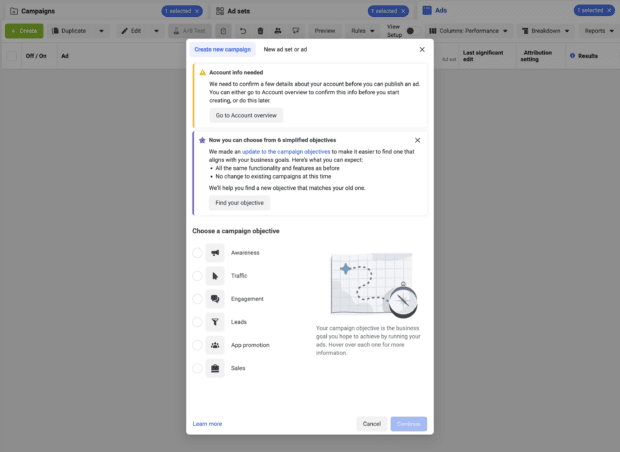
Step 3: Name your campaign
After selecting your objective, you’ll be prompted to name your campaign.
Pro Tip: Give it a specific name based on the campaign objective to help you keep track of your campaigns.
Once you’ve chosen a name, click Next.
Step 4: Choose your budget and schedule
Once you know what you want your ad to look like, choose New [your ad goal here] Ad Set from the left-hand menu.
Here, you can choose how much you want to spend and how long your campaign will run.
For your budget, you’ll have two options:
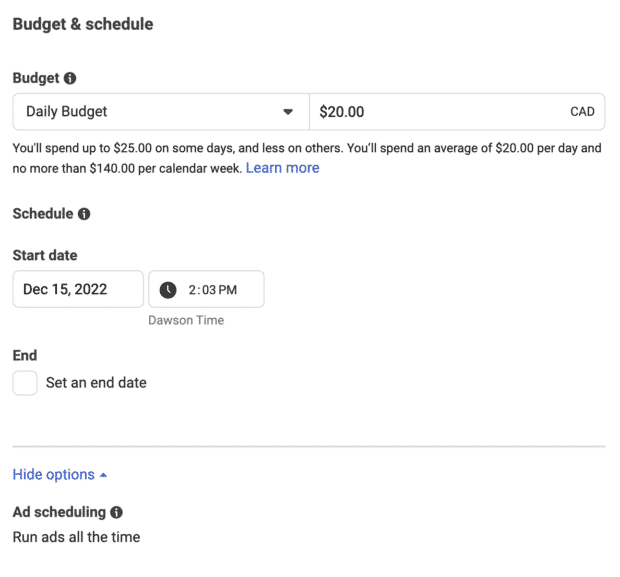
Daily budget: Set a maximum daily spend, useful for always-on ads
Lifetime budget: Set a maximum spend for your whole campaign, useful for ads with a clear end date
Under Ad Scheduling you can choose to run ads continuously (most common), or only at certain times of day (for example, if you’re a food delivery company and only want to run ads in the evening when your audience is most likely to place delivery orders).
As you adjust these options, you’ll see the Audience Definition and Estimated Daily Results modules in the right-hand column, which will give you an idea of your budget’s expected reach.
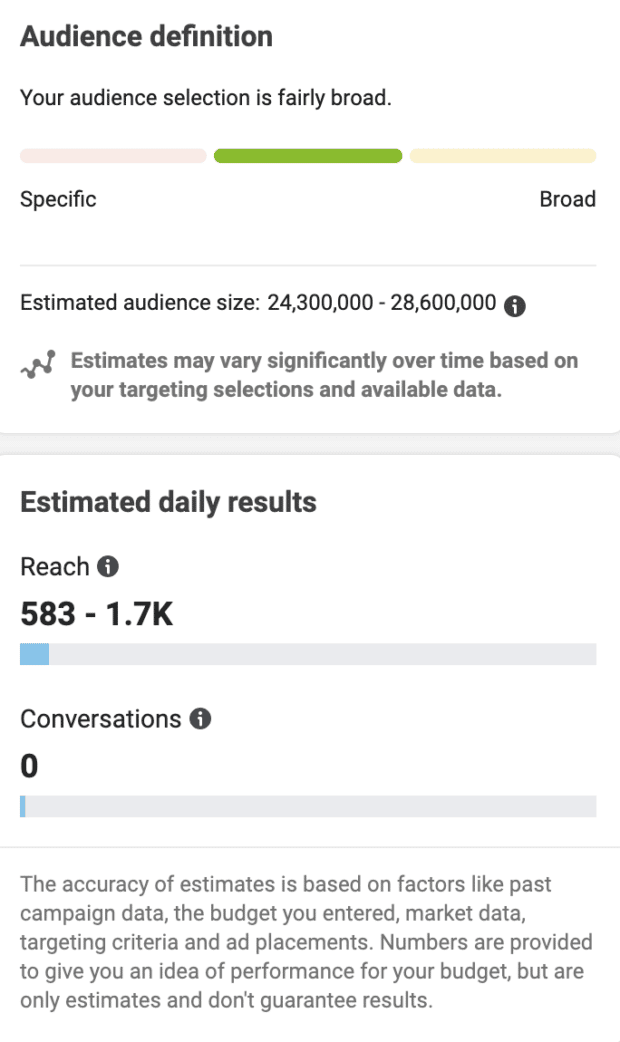
Pro tip: Try to make your ad set fall in the middle of the green range.
Step 5: Identify your audience
Now it’s time to choose your audience.
You can either use a previously saved audience or create a new audience.
Saved Audiences are useful if you have your own custom audience data (i.e. past website visitors) or past audiences from previous campaigns that performed well. If not, you can create a new audience based on demographics, interests, and behavioral targeting.
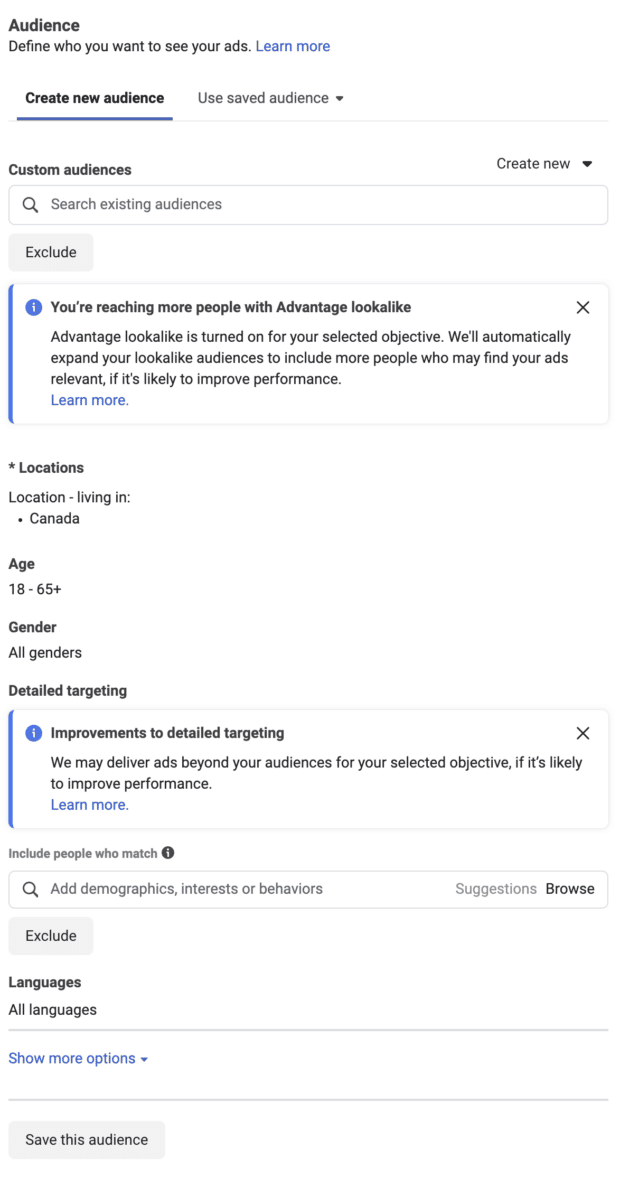
If you choose to create a new audience, you’ll have the option to target by location, age range, gender, demographics, interests, behaviors, and languages.
Step 6: Choose your Instagram ad placements
In the Placements section, you can decide where your ads will appear.
There are two options:
Advantage+ Placements: Ads will be shown to your audience wherever they’re likely to perform best.
Manual Placements: You can choose specifically where your ad will appear (and not appear). If you want to limit your ads to show only on Instagram (not Facebook), you can choose these using Manual Placements.
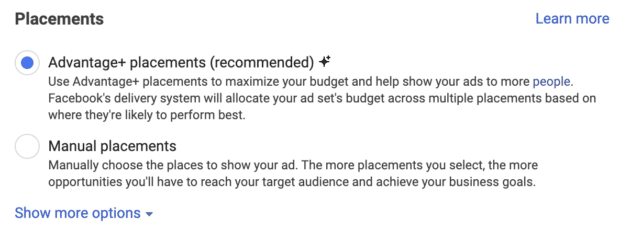
If you choose manual placements, the Ads Manager will display the technical requirements for each one. To ensure your visual assets are optimized for each format
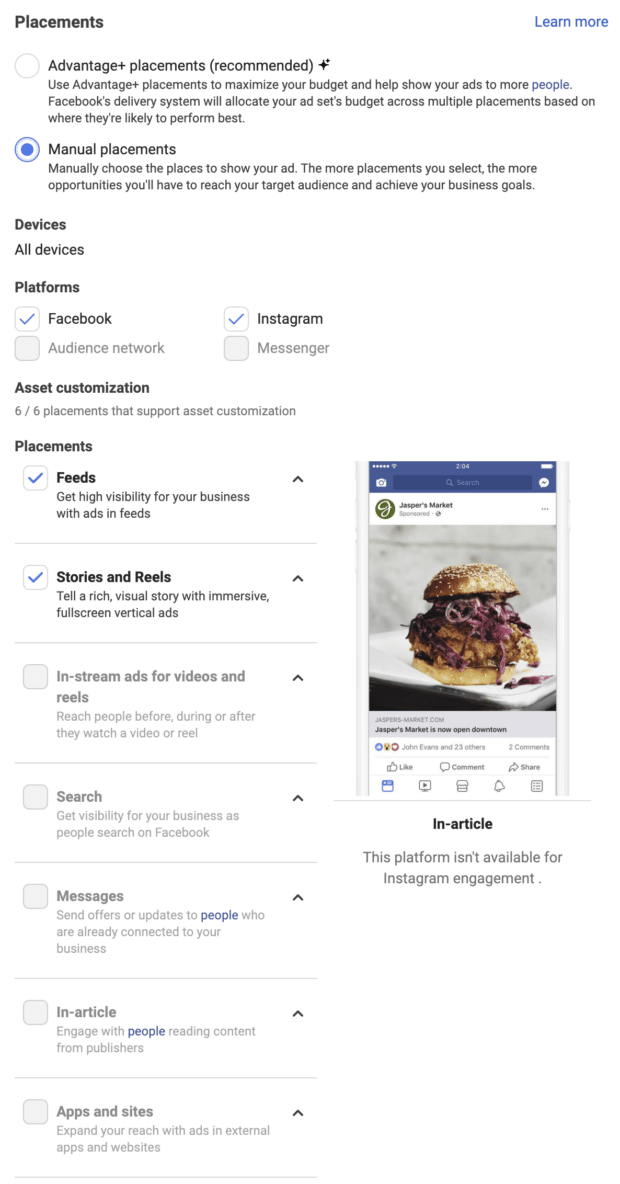
If you’re new to Instagram advertising, we recommend going with Advantage+ placements.
Step 7: Create a new Instagram ad
Finally, it’s time to create your new Instagram ad. Choose New [your goal here] Ad from the left-hand menu. This will open up a screen where you can customize your new Instagram ad.

Here, you can edit your ad name, choose from different Instagram ad types, and add creative elements like images, videos, headlines, and CTAs.
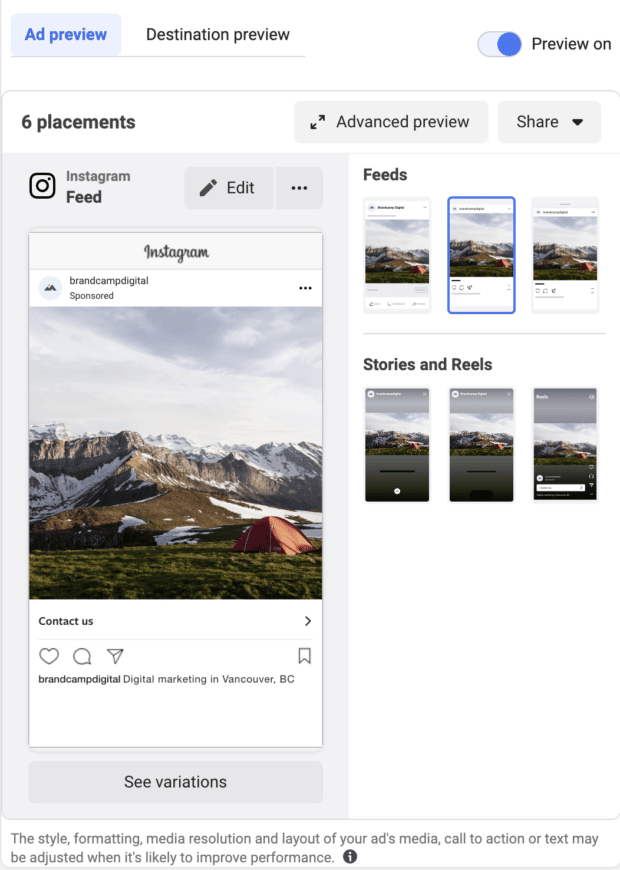
You can also add any copy, website links, and tracking parameters on this screen.
If you want to track conversions from your ad, it’s important to select the Facebook Pixel in the Tracking section.
Once connected to your website or app, your Facebook pixel will allow you to see insights about how your audience interacts with your business after clicking on your ad.
Step 8: Publish your Instagram ad
Once you’ve filled out all the necessary fields, click Publish in the bottom right-hand corner of your screen.
Your Instagram ads will now run on the chosen budget and timeline. Be sure to check your Instagram Analytics regularly to see how your ads perform.

